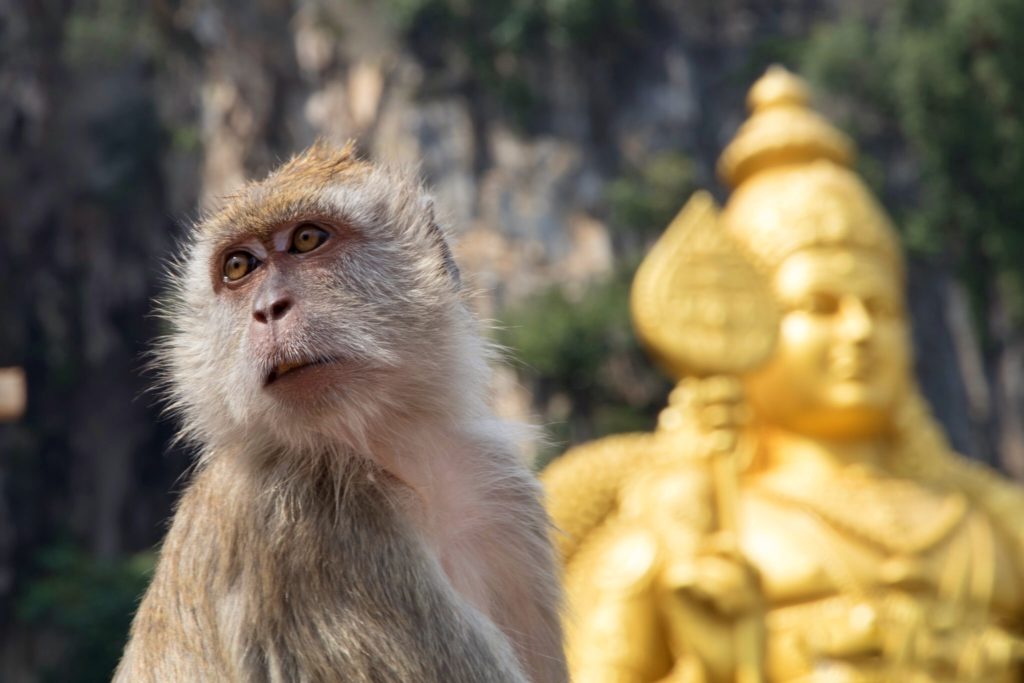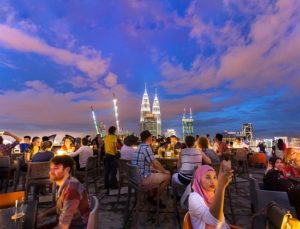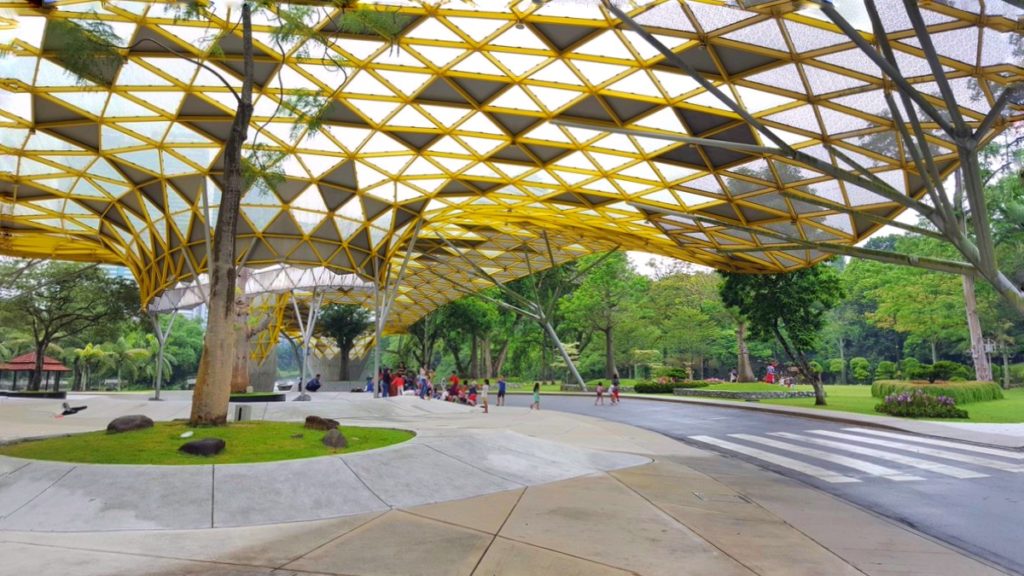Kuala Lumpur has long been a home to leafy canopies of tropical trees. These days, as skyscrapers dominate its skyline, the drive to reconnect Malaysia’s capital to its green origin is making a comeback.
Kuala Lumpur is going through an identity crisis. For visitors, it is a place that embraces idle wanderers. To locals, a restless teenager clamoring for justice whilst trying to get drunk on teh-tarik.
To me, the city is neither. KL, as it is often referred to, is a city that I have loved and lost and could not help loving it again and would go on loving.
It wasn’t long ago when I left Malaysia’s storied capital and drifted momentarily in Europe before finding myself living in Manhattan’s Upper East Side. In the quiet, leafy neighborhood of Bangsar, a residential suburb of the city, we rented an apartment that faced a patch of tropical woodland.


It was nothing but idyllic. A place where the city’s urban roar is hushed by a symphony of cackling birdlife, humming insects and squeals of monkeys playing next door, unbothered by the 21st century. Although it is not exactly a tropical paradise that famous people might write about, it was enough to inspire dreams in small children. Out of the many things I am most nostalgic about living in KL are the monkeys that had been our closest neighbors.
In the copious hot-monsoon years we’ve spent together, we have not reckoned the city’s growing hunger for infrastructure and property development. Quiet without noticing, my tree-dwelling neighbors left, and one day a humongous drilling machine materialized and stood outside our bedroom window. The hills of Bangsar appeared claustrophobic. The city and its construction seemed to have grown stale to our eyes. Like the monkeys who left to find a new prospective future home, so did we.
What is it with cities that lend us happiness? Sometimes when you are away for so long, it is the sights that you remember; at other times it is the energy.
Fast forward to the present time, as I was putting up last-minute touches on a project I was working on and while waiting for a new assignment in New York City, I received a call from a friend who was looking for a companion to travel to Thailand for a few days. I was happy to volunteer and thought of how close Thailand is to Malaysia. Perhaps I could make a little sidetrip south, before the end of our trip. Did I want to go back home?
The Kuala Lumpur I know and was led to believe (and still hope to believe) is a sprawling jungle with pockets of urban boroughs. Somehow, that notion seemed to lose its luster. Every year, the city grows. Sprawling construction of new erected condo towers and malls has replaced wooded areas, shrinking the remaining city’s green spaces. Although Kuala Lumpur is dubbed, a city jungle by many, and protected rainforests occupy almost a quarter of the total land area, experts would argue that for a city of 1.7 million people, the city’s challenge is to expand economically and at the same time sustainably.
My trepidation about revisiting after years abroad is to be confronted with the rapid metamorphosis of the city that I used to know and the city that I am about to see. Sometimes when you are away for so long, it is the sights that you remember; at other times it is the energy. It immediately became clear to me that in this instance, it is both.

 Yes, I do remember the typical face of hypermodernity. Skyscrapers that gleam in the daylight and put on a shimmering flapper-dress come nightime. I remember the emblems of innovation that are seen in transit stations. Trains that whisk you away from the airport to the city and back in minutes, make my New York train rides (and stations) look and feel medieval.
Yes, I do remember the typical face of hypermodernity. Skyscrapers that gleam in the daylight and put on a shimmering flapper-dress come nightime. I remember the emblems of innovation that are seen in transit stations. Trains that whisk you away from the airport to the city and back in minutes, make my New York train rides (and stations) look and feel medieval.
I remember as well the aspirations of the city and its diverse multi-ethnic inhabitants. The can-lah, can do spirit to do something better than the ordinary. And how I am being reminded of a generation that speaks of change – of political landscape, perceptions on race and LGBT issues, as well as environmental concerns.
If there is one revelation that I considered nouveau that my recent trip afforded me is that conversations on creating more green spaces have finally caught on and are given more attention these days. Like transforming parking spots to small gardens. The drive to inject ideas of microhousing, communal living and shared spaces are attracting more environmentally conscious millenials.

 “There is a great demand for spaces in cities and the greatest challenge is to rejuvenate existing urban spaces as opposed to expanding”, according to Hamdan Abdul Majeed of ThinkCity, a Malaysian community-focused urban regeneration organization that aims to create more livable, resilient, and people-centric cities.
“There is a great demand for spaces in cities and the greatest challenge is to rejuvenate existing urban spaces as opposed to expanding”, according to Hamdan Abdul Majeed of ThinkCity, a Malaysian community-focused urban regeneration organization that aims to create more livable, resilient, and people-centric cities.
Even hotels have evolved into something more of a representation of the city’s green idea. Take the Element Kuala Lumpur, a Westin brand hotel just a few blocks away from Malaysia’s iconic Twin Towers. With its soaring 275 meter height, this Green Building Index (GBI) certified hotel, affords its guests an entrancing 360 degree view of the city’s skyline while also keeping watch on the indoor air quality with its sensitive CO2 sensor.
The hotel seems to have taken things further when it comes to water recyling through its rainwater harvesting technology as well as its non-chemical water treatment. Kuala Lumpur gets 100 inches of rainfall annually and it might as well be that the hotel is poised to meet the challenge of energizing the idea of a green city.


 I have heard that while guests are pampered in comfortable, contemporary rooms awash with natural light as a key element in its design, they are also encouraged to take part in free yoga classes. There is an indoor saltwater pool, a true work of art in itself and the highest in the city. It occurred to me that the pursuit of an eco-conscious philosophy is also synonymous with health and wellness.
I have heard that while guests are pampered in comfortable, contemporary rooms awash with natural light as a key element in its design, they are also encouraged to take part in free yoga classes. There is an indoor saltwater pool, a true work of art in itself and the highest in the city. It occurred to me that the pursuit of an eco-conscious philosophy is also synonymous with health and wellness.
One afternoon, I ascended to the hotel’s restaurant on the 40th floor for a sugar rush and treated myself to an ARTEASTRY (art-tea-pastry) menu. I noshed on some repasts of varying flavors, from savory to tasty to succulently sweet. The highlight of which was the chef making a sketch of a forest out of dark, melted chocolate. I was taken by his artistic flair and the image it conjured in me – the tropical forest we had in the suburban hills of Bangsar and, along with it, my tree-dwelling neighbors, swinging from one branch to the next and leaving a squeal of glee and contentment in their wake.
Just very recently, Kuala Lumpur hosted the 9th World Urban Forum 2018 where talks circulated on the role of nature in achieving a more livable city of tomorrow. With the city’s shifting mindset to be more robust in its efforts in becoming a leading green city, it may not be hard to imagine KL’s previous landscape depicted in the pages of the fictional works of Somerset Maugham and Joseph Conrad who had also traveled to Malaysia.
To echo the words of Chuah Guat Eng, Malaysia’s first English-language woman novelist, “There are many things happening around the city that caused me to worry…As a fictional writer, cities and towns are like metaphors and symbols.”

Perhaps more than preserving Kuala Lumpur’s oldest forest eco park in Bukit Nanas, breathing new life to old buildings, revitalizing car parks back into green spaces, it’s only with steadfast commitment and unified green ideology among its inhabitants that would make Kuala Lumpur, this great metropolis, a city ready for the future.
What is it about cities that lend us happiness? A city can make you feel like home to those who are drifting and lost. Sometimes it robs you – of innocence and ignorance. Other times, a city may even break you, and yet, bestows a kind of comforting affection and an eagerness to listen to anyone’s inner monologue.
Malaysia’s capital can really throw everything at you. The punishing heat, the stifling humidity, traffic and gridlock, the crowd in the rush hour and the always flooded and wet public restrooms yet you find yourself greeted warmly by a city of random curiosity and fascination, of unforgettable experiences and encounters – making it possible to overlook its imperfections and daily tantrums. Kuala Lumpur, what’s not to l❤ve?
BUTTER MY BAGUETTE
This website made of love strives to produce FREE CONTENT.
Help me tell more stories and keep this website free of any advertisement by supporting Flying Baguette in inspiring more people and connecting you with other cultures and communities around the globe. Donate a little or as much as you can afford to keep the magic of Flying Baguette going for years to come. Share your support through the icons below ⬇️


















Arty pastries, jungle meets city, and lots of great things to see and do. KL looks like my kinda place. I understand what you mean about being hesitant to go back somewhere you remember in a certain way. I felt the same way about Beijing. A city I loved but whose development was taking over. Part of that feeling could also be the stage of life you were in at the time and lots of other factors that can make you see it in a different way, but I’m glad you decided to return, and share the city with us
This is a great example of a city that is growing, that has learned from other cities what to do and NOT to do. The idea of preserving green spaces is something relatively new in cities – really over the past century or so, you mentioned that you relocated to Manhattan and i’m sure you know of Central Park. Many older cities never really preserved large spaces (like Central Park) for recreational use, so it’s good to see KL doing the same but in a modern way. I would hate the heat and humidity (and probably the bugs too) but the food and architecture look incredible in your photos!
Your post makes Kuala Lumpur a bit more accessible and a bit less overwhelming. That Arteastry looks almost too good to eat. I love that they’re working to preserve the eco park too and participate in the World Urban Farm. Sustainability in cities is difficult but I love to see the effort.
The combination of heat and humidity would be torture for me, especially when combined with the fact that KL is a metropolis, I think it would be overwhelming for me. However, after reading your unique and interesting perspective on Kuala Lumpur, I would be willing to give it a chance to explore the city.
As an urban planner, I studied KL as being a good case-study example of urban planning and with good attempts and practices regarding the management of public spaces. I believe that there is still a lot of work to be done to preserve green spaces, but they are on the right track…it seems to me! So it would certainly be interesting, from a professional perspective, to visit the city.
Interesting perspective and insight into how you connect with a place Jan. KL would not necessarily be a place I would find too interesting visiting, as I understand it is really a metropolis for a working lifestyle with not too many historical sites, which usually helps me to build a first connection. I’m positively surprised to read that it is ever changing, and the city actively investing and planning urban spaces at a rather rapid speed. I do value clean spaces, wide open green parks and modernity but I doubt it would keep my attention for as long as KL has kept yours. It is also surprisingly small at just 1.7 million. With it’s impressive skyscrapers and futuristic trains I would have expected a much larger population.
Carolin | Solo Travel Story
You described your reaction to revisiting your hometown vividly. It is always a shock to the system to see changes over the years. I like that KL is moving more towards preserving green space and is recognizing that unbridled urban growth is a problem. I have a good friend who lives there and might be getting a visit very soon!
Lyn | http://www.ramblynjazz.com
We find heat and humidity really difficult when travelling but, despite this, Kuala Lumpur is calling to us, especially the food scene. It was fascinating to read about how KL had changed for you over the years. And how the city’s expansion is looking to be as sustainable as possible. Love the green credentials of the Element hotel and, well, Arteastry looks sublime!
The monkeys always know……
We should have been in KL in July. This would have been our second visit. Such an interesting city with amazing food!
What a beautiful post. We almost planned for this for December, but wow that holiday is in the air. Bookmarked for the future!!! 🙂
Very happy to have come across your writing. Love your style!!! And found this post very interesting, having travelled to places many many years later ourselves.
Its awesome that KL was once again able to offer you unforgettable experiences.
We may be overdue for a visit, we were last there 20 yrs ago.
What an incredible way to see your home city. I love KL but it’s a sweaty concrete jungle at times. The local foods help to keep me going that’s for sure!